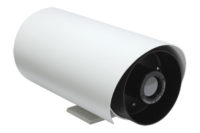Surround Sound
Perimeter solutions deter, detect and delay unauthorized security breaches.






When the 16-acre campus of the new World Trade Center and Memorial and Museum was being designed, architects were solely focused on building the strongest structure they could. But New York City officials targeted their attention to how to secure the perimeter of what is certain to become a significant attraction, expecting to host more than 250,000 travelers per day when it opens in 2014. Diebold, Inc. will design and implement the security system for the facility, where the World Trade Center Transportation Hub will re-establish the transportation infrastructure and facilities in existence before September 11, 2001, and transform Lower Manhattan into the third largest of the transportation centers in the city.
The Hub will be the home of the Port Authority Trans-Hudson Corporation rapid transit system and connect to 11 different subway lines. The Hub will also connect pedestrians to the terminals of the Hudson River ferry and the World Financial Center via underground concourse.
Diebold’s perimeter security system will include alarm devices, biometric access control and video surveillance. A centralized command center, stairwell crossing system and destination-based elevator controls round out the perimeter security measures.
Police plan to use a vehicle security center to screen tour buses, trucks and cars before they enter the site and park or makes deliveries using an underground roadway. Pedestrian traffic, including visitors to the museum, also will be screened before they can enter the central plaza. Final touches are also being put on another ambitious piece of the plan: Screening every car, truck and other vehicle for radioactive materials and other potential threats as they enter lower Manhattan. To achieve that, police are installing cameras, radiation detectors and license-plate readers at the 16 bridges and four tunnels going in and out of Manhattan.
Officials claim that the combination of architectural innovation, high-tech gadgetry and good old-fashioned manpower provided by the NYPD, the Port Authority of New York and New Jersey police and private security firms will make it a very secure site.
Whether in NYC or around the country, the increased threat of terrorism continues to be the key driver in securing facility perimeters. Protection should be based on site layout, area sensitivity, the surrounding environment and activity within the site. A layered perimeter intrusion detection system (PIDS) should act as the first level of site protection, providing an early warning of intrusion attempt.
“Having perimeter security mitigates most of the challenges in being able to detect, deter and identify people who seek mischief on your campus,” says Christopher T. Mark, MBA, CSA, corporate director of security for American Sugar Refining, Inc., a cane-sugar refining company in the U.S., with facilities across the nation plus in Europe, Canada and Mexico.
Sweet and Secure
“Having an unsecured facility can imply that the protection to your people, product and assets are vulnerable, which can have an adverse impact on your company and brand,” says Mark.
In managing port facilities, the implementation of a perimeter security solution is necessary for compliance to the International Ship and Port Facility Security Code (ISPS), which requires a comprehensive set of measures to enhance the security of ships and ports. These requirements apply to any structure or facility located in, on, under, or adjacent to any waters subject to the jurisdiction of the U.S. and used, operated, or maintained by a public or private entity.
For facility operators, like the American Sugar Refining Inc., this means they are subject to satisfy inquiries from customers, vendors and agents about the security of their facility. “American Sugar is expected to protect its people, product and facilities (port and refining),” says Mark. “To not have perimeter security could leave a facility vulnerable to domestic and international terrorism.”
At American Sugar, perimeter solutions include security video, detection devices, employee screening, key control, alarms, card access and contract security services. Access control is used for facility entry via turnstile gates, external gates, facility doors and perimeter fencing. A defined security perimeter around the entire company premises is in place to allow entry to only authorized personnel. Visitors are manually processed by recording their identity, and entry/departure dates and times.
Access control procedures require American Sugar port terminals, as well as refining and non-refining facilities, to ensure the implementation of security measures to prevent dangerous substances and devices from harming people, products, vessels, facilities or ports. Some of these processes, however, are not always conducive to moving cargo expeditiously, says Mark. “Some of the access applications are time consuming and the measures in place to control access and prevent operational interruption do just the opposite. For example, the flow of trucks into the facility slows down due to the increase of vehicle inspections. And the efforts to unload cargo ships and the movement of trucks are methodically processed. The purposes of perimeter security solutions are to deter, detect and delay. It is unfortunate that this very same process can also slow down facility activity.”
Delivering on Safety
Logistics companies like ABF Freight Systems, Inc. understand speed and slow is not an option. Neither is leaving cargo unprotected. ABF began installing security systems back in 1997 after a group of organized cargo thieves broke into one of the logistics company’s Florida-based facilities, and reports of theft from other carriers’ sites in the Miami area. The thieves initially stole small items from the loading docks and from within parked trailers, then upped the ante by taking loaded trailers from truck yards.
ABF has 274 U.S. service centers that handle thousands of freight shipments a day. As shipments move within the ABF system, they may be located within the facility or loaded onto trailers in preparation for transit. Protecting customers’ freight is a priority, therefore ABF uses several security measures, including perimeter security systems. “ABF has designed its transportation system so there is little or no time period where a trailer containing freight sits unattended,” says Sam Cates, director, safety and security at ABF. “On the few occasions where a trailer may be briefly parked at a facility, our perimeter security system provides an added security barrier that complements our cargo security procedures.”
Perimeter security systems from ADT Security Services, Inc. include motion or contact sensor alarms on buildings and fencing around the facility. Electronic fencing called The Electric Guard Dog from Sentry Security Systems, LLC, is used around areas determined to have a higher potential of theft or where ABF has received reports of thieves cutting fences to gain access to facilities. Some locations employ a security guard service.
Since the installation, ABF has experienced a couple of incidents where an unsuccessful attempt was made to dig/tunnel underneath the electronic fences and numerous alarm activations have occurred. “More often than not, the police and a company representative respond only to find no problem at the facility or find that an attempt had been made, but the audible alarm activated and scared the perpetrator away,” explains Cates.
It is that success that justifies ABF’s expense of millions annually for security. “In the LTL (less-than-truckload) environment, a single trailer can contain multiple shipments from multiple customers and one theft of a single trailer could jeopardize losing several customers. Theft prevention provides the main basis for our projected ROI. Having product stolen is expensive for the bottom line, but is also taxing on our customer relationships. An investment in security is an investment in our customer relationship, which is always good for business. Our perimeter security systems provide assurance to our customers that ABF is taking the steps necessary to handle their shipments safely and securely while in our care.”
No Great Escapes
Sometimes, perimeter security is not so much about keeping folks out as it is about keeping them in. The State of Florida’s Department of Corrections has 71 major institutions that house 85% of the state’s inmate population. Each of these facilities has a different security level depending on the type of inmates housed at that particular facility. Therefore, an appropriate perimeter alarm system must be used to assist the department in maintaining a secure environment, explains Dennis Smith, Const. Project Consultant II, Northern Florida Region.
“I started with the department 20 years ago and I have seen a lot of changes in our perimeter alarm systems. We are constantly trying to improve on our perimeter systems. The days of the officer with the shotgun are still with us, but they now get help from electronic systems. If you have anything worth protecting, you need one of some type of perimeter security.”
The types of perimeter solutions that the Florida Department of Corrections uses are microphonics, microwave, fiber optics and non-lethal power fences. These systems aid the roving patrols in providing constant alerts to the individual institution and the control room staff that monitor the alarm activities occurring on the perimeter. Some of the institutions still rely on some manned towers for additional perimeter security.
“All of the perimeter systems in place run 24/7/365 and are always watching for any activity that may occur concerning the perimeter fence system,” says Smith. For certain areas around the perimeter fence, Dopplers provide additional coverage and report suspect activity.
He warns, however, that Dopplers and the other technologies only warn of a problem, but don’t actually apprehend a suspect. “These systems are not a replacement for the human factor.” The combination of technology and people power has proven successful for the Florida Department of Corrections; Smith says there has not been an escape in more than 12 years. “We have had escapes from Work Release Centers and outside work squads but not from inside any Institution or Work Camp,” he points out.
Unprotected perimeters mean unprotected assets, unprotected people and inevitably security breaches. The ramifications of these breaches can be catastrophic, so the threat of intrusion remains a prime concern for all facilities. In the wake of 9/11, conventional security patrols cannot effectively cover perimeters, so more advanced perimeter intrusion detection systems have become the answer.
Looking for a reprint of this article?
From high-res PDFs to custom plaques, order your copy today!





